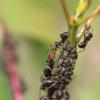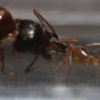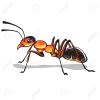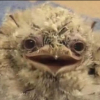So about 2 months ago I caught a Tetramorium queen and to this day she has about 13 workers and a pile of larvae.
The start: She started off in a test tube for 2 days until I moved her into a Tarheel Ants Atom A Chamber and from there she started her colony. It took about 2 weeks for her eggs to become larvae, and about 2 weeks for the larvae to pupate (sp?) and about 2 more weeks for the pupae to become nanitics. A month and a week later from when I first caught her, her first workers arrived and for their first meal I decided to give them honey and thoughtout the day I always saw atleast 1 nanitic drinking the honey. 2 days after their sugar fix I decided to give them the head of a large mealworm which they pretty much ignored except 1 ant.
The Move: About 2 days ago I decided to move them into an Small Tarheel Ants Inception chamber made specifically for Tetramorium. Within 7 hours they all moved into the chamber and later that night I pushed the head of a mealworm into the entrance and they took it in and feasted. The next day the entrance from the chamber to the outworld was blocked with sand so I was kinda worried about the mealworm head molding. Today, luckily they moved the head to the chamber that receives no hydration so I'm pretty happy.
So yeah that's how my colony is doing so far, let me know if I should continue and feel free to leave suggestions. Peace out.




































